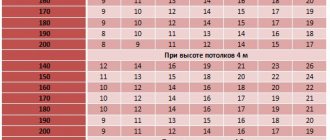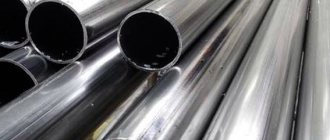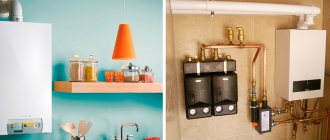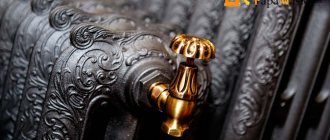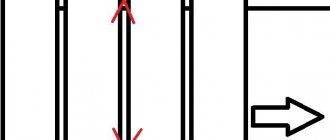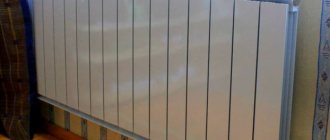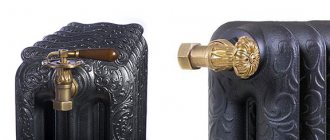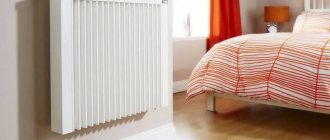Design features of cast iron radiators
Cast iron radiators are the most durable.
The batteries have the most traditional appearance. The design includes several sections connected to each other by nipples. To seal the joints, heat-resistant rubber or paronite is used. The coolant channels inside have a round or elliptical cross-section. They produce one-, two- and three-channel sections.
The batteries are cast from gray cast iron. The material is wear-resistant and durable - radiators last more than 50 years. Salts are not deposited on the walls, small debris or sand does not cause damage. Even after 30–40 years, the diameter of the working channels remains almost unchanged.
The size of a cast iron battery depends on the number of sections. The size is selected based on the size of the heated room. But if the width of the product is determined by the number of elements, then the height and depth depend on the structure of the sections themselves.
The appearance of the product is unattractive. More modern models are produced with a flat front panel. Decorated with forged elements.
Main disadvantages
Cast iron radiators are not without serious disadvantages, including:
- Heavy weight. The thick walls and size of cast iron heating radiators complicate transportation, especially if heating devices need to be raised to the upper floors of a multi-story building without an elevator. Installing batteries is problematic to do alone, especially if they are not installed on the floor, but attached to the wall.
- Features of the form. Due to the sectional nature of the cast iron battery, the surface area is relatively small when compared with other types of heating devices. The bulk of the heat is transferred by radiation, convection is practically absent, which slows down the heating of the room.
- Appearance. Old-style serial radiators can hardly be called aesthetically attractive; in addition, the batteries may require painting with special paint for radiators. It is important to remove the previous decorative layer so that the heat transfer of the battery does not decrease. If the battery is covered with a decorative screen for aesthetics, this also leads to a decrease in heat transfer.
- Thermal inertia. The same property is both a minus and a plus. Cast iron radiators cool down slowly, which may be needed in some cases, but cast iron radiators heat up very slowly when the heating is turned on. Due to thermal inertia, such heating devices cannot be used in a system with flexible temperature control in rooms. This means that they are not suitable for cost-effective independent heating systems.
- Fragility of the material. Cast iron may not withstand a pinpoint impact from a heavy object and may be damaged if dropped onto concrete or stone. During operation, microcracks expand under the influence of high temperatures, as a result of which the battery can leak. In the same way, cast iron is destroyed by sudden temperature changes.
- Tendency to overgrow. The rough inner surface promotes the accumulation of deposits. Since the internal cross-section is quite large, the battery will not become completely clogged for a long time, but its heat transfer will decrease. It is recommended to flush the heating devices of the autonomous system every few years.
- Large internal volume. The more coolant required to fill the system, the higher the energy consumption for heating it.
Cast iron radiator MS-140M
The disadvantages of cast iron radiators often include relatively low peak pressure compared to bimetallic heating devices. Cast iron batteries can withstand pressure surges of up to 15 atm, while bimetallic batteries can withstand pressure surges of up to 40 atm. However, in the central heating network the pressure does not rise above 15 atmospheres, thanks to which numerous cast iron batteries work perfectly for decades. And in the autonomous system the pressure is much lower than in the central one.
Advantages and disadvantages
Modern design solutions
The advantages of the product are determined more by the material than by the design. Main advantages:
- Cast iron conducts heat well and accumulates it. The radiator takes longer to heat up than a steel or bimetallic one, but gives off heat for a long time after the boiler is turned off. An hour after heating stops, the residual heat transfer for cast iron models is 30%, while for steel models it is only 15%.
- The water used in central heating is not clean. Salts, mechanical impurities, sand destroy the pipeline material. Debris is deposited on the walls: the working diameter decreases over time, and the efficiency of heat transfer decreases. Cast iron is not afraid of salts and abrasive particles. After 30 years, the batteries work as efficiently as on the first day after release.
- Cast iron batteries cannot withstand constant high water pressure, but they are not afraid of water hammer. This option is used when arranging heating with natural circulation.
- Radiators last at least 50 years. If you change the gaskets on time, it will take even longer. Usually they are replaced not because of leaks or low efficiency, but to make the interior more modern.
- The price is the lowest among heaters.
Disadvantages of radiators:
- The main disadvantage is its considerable dimensions and heavy weight. The 8-section model weighs more than 60 kg. They are difficult to transport, lift to the top floor, and install.
- If when the heating is turned off, high thermal inertia acts as an advantage, then when turned on it turns into a disadvantage. The room warms up for at least 12 hours.
- To service the batteries, you need a large volume of coolant and a more powerful boiler. This is not a hindrance for central heating, since the system was originally designed to transfer a large amount of coolant. For an autonomous one, this is a significant drawback.
- There is no need to talk about design. Rough, heavy radiators hardly fit into the interior.
The advantages of a cast iron battery are well demonstrated in central heating systems. The disadvantages are visible when autonomous heating is installed.
Main advantages
The advantages of a cast iron radiator traditionally include:
- Corrosion resistance. A feature of cast iron is its resistance to oxygen, due to which such heating devices can be used as part of open heating systems, as well as operate in the mode of regular filling and draining of coolant. Steel radiators quickly rust from the inside after the system is emptied and fail after 2–3 years of operation in “ragged” mode.
- Undemanding to the acidity level of the coolant. Cast iron batteries are not afraid of acidic or alkaline environments and are suitable for systems filled with antifreeze.
- High temperature resistance. The batteries can withstand heating of the coolant up to 150 C°. Such technical characteristics make the heating device suitable for gravity systems with a solid fuel boiler, where it is difficult to regulate the heating of the liquid.
- Quite a large internal cross-section. Thanks to this, washing is not required very often.
- Heat storage properties. Thick-walled cast iron radiators have an important property - they retain heat for a long time. After turning off the heating, the radiator will cool down gradually, and after an hour the thermal radiation will be approximately 30% of what it was when the boiler was stopped. The ability to retain heat in cast iron heating devices is several times higher than that of batteries made from other materials, which makes them the preferred choice for autonomous systems with a solid fuel boiler that requires loading fuel more than once a day.
- Durability. The thickness of the walls of cast iron batteries contributes to long-term operation, provided that the material is of high quality and optimal operating conditions. There are examples of successful operation of radiators made a hundred years ago, and examples with Soviet batteries that begin to “crumble” after 20–30 years of operation. Manufacturers estimate the service life of their products at 10–30 years, but in fact it can be much longer.
Cast iron radiator Demir Dokum (Türkiye)
Specifications
The choice of cast iron batteries is small. Most of the older models were abandoned. The new ones try to reduce the volume of coolant, improving heat transfer due to a larger number of channels and creating a flat surface.
The technical characteristics of the most popular models are given below.
| Brand | Working pressure, atm | power, kWt | Heating area per 1 section, sq. m | Water volume in 1 segment, l | Weight of 1 segment, kg |
| MS-140 | 9 | 0,12–0,16 | 0,244 | Up to 1.45 | 5,7–7,1 |
| World Cup1 | 9 | 0,075–0,11 | Up to 0.165 | Up to 0.9 | 3,3–4,8 |
| World Cup2 | 9 | 0,1–1,14 | Up to 0.207 | Up to 0.95 | 4,5–6,3 |
| World Cup3 | 9 | 0,1–0,15 | Up to 0.246 | Up to 1.38 | 4,8–7 |
Models are selected mainly by power. Comparing the characteristics of sections allows you to quickly calculate the required dimensions of the heater.
Height
A parameter that affects not so much the heating efficiency as the aesthetics. The height of the cast iron standard battery is 59 cm. Models are available with heights from 33 to 95 cm. The working surface of each section varies depending on the height. This is taken into account when calculating their required number.
Low radiators look more attractive even with a standard configuration.
Size
Product dimensions vary greatly:
- height – from 33 to 95 cm;
- depth – from 8.5 to 20 cm;
- width – from 4.4 to 10.8 cm;
- the interaxial distance varies from 22 to 90 cm.
Size information is on the label. If the model has a non-linear shape, the depth is not specified.
The most important parameter - the length of the battery itself - depends on the power. The more sections, the larger the area the radiator can heat. However, there is a limitation here: if the length of the battery is 4 times the height, it must be connected on both sides, and this is not always possible or convenient.
Power
The indicator is calculated according to the following parameters:
- volume of the room;
- quality of insulation;
- water temperature;
- power of one section of a cast iron radiator - this indicator is indicated in the product passport.
On average, at a normal level of heat loss, heating 3 cubic meters of air in a room requires 1 kW.
The calculation is performed as follows: the area of the room is multiplied by 100 and divided by the power of the sections of the selected model. For example, with an area of 10 sq. m. and a segment power of 150 W is 10*100/150 = 6.67. Round the result up - to heat the room you will need a radiator with 7 sections.
It is recommended to increase the calculated value by at least 15%. To heat a bedroom of 10 square meters. m. it is recommended to buy batteries with 9–10 elements.
The height of the room should be taken into account. With the same area, but with a ceiling height of not 3.5, but 4 m, heating with a radiator of the same power will require at least 12 sections.
Other factors are also taken into account. If there are 2 windows in the room, it is better to install 2 radiators of 5 sections in order to evenly distribute the heat and neutralize the cold air.
Low cast iron heating devices
The most famous low accordion radiator is MS-140M-300-0.9 (made by Belarusians). Its dimensions:
- Center distance – 0.3 m.
- Height – 0.388 m.
- Depth – 0.14 cm.
- Width – 0.93 cm.
Two more popular models of accordion-type devices can be called MS-110 and MS-90 . Their inter-nipple distance is 0.3 m, the height ranges from 0.382 to 0.388 m . Products with a distance between axes of 0.35 m are also common.
The lowest cast iron batteries reach 0.4 m.
Design radiators are the lowest. BOLTON 220 reaches 33 cm, and Hellas 270 products from Viadrus - 34 cm. Most representatives of designer heating devices reach up to 40 cm.
Selection rules
Radiators with a flat surface have higher efficiency.
The recommendations are simple:
- The most important thing is the correct calculation. The power of the section is assessed and the efficiency of the entire heater is calculated. If there are not enough sections, increasing the temperature of the coolant will not improve the situation; the room will be cold.
- You need to choose the height. If the product is mounted under a window, there should be at least 20–15 cm between the radiator and the window sill, and at least 5 cm between the floor and the bottom edge of the product. For large windows, choose low radiators and compensate for the small height with a large number of sections. Tall radiators are mounted near blank walls.
- Batteries with a flat surface have higher efficiency and are more attractive in appearance. Models with artistic casting and decorative coating fit perfectly into retro, classic, and rustic interiors.
- Radiators are mounted on the wall using special brackets. However, there are floor-standing models. The latter are used if the walls cannot withstand such a heavy load.
The appearance of the battery can be radically changed by covering them with a decorative grille or screen.
About the design and types of cast iron radiators
Each radiator, like a construction set, is made up of several identical sections. They are cast at the factory from gray cast iron. The channels through which hot water flows can be round or elliptical. At the assembly stage, the sections are connected to one another using nipples, and the joints are additionally sealed. To do this, use heat-resistant rubber or paronite gaskets.
Based on the number of channels in one section, they can be:
- single-channel;
- two-channel.
Cast iron radiators can have different widths (which depends on the number of sections) and heights. The width of the radiator depends on the volume of the heated room, the number of windows in it, and the thickness of the external walls. After all, the more sections are used, the more heat the radiator will give off. As for the height, it can vary from 35 centimeters to one and a half meters. Let's not forget to look at such an indicator as the depth of the radiator. After all, it depends on her how these cast iron products will fit into the design of the room. Depth can range from 50 to 140 centimeters or more.
For installation you will need special durable brackets that must be securely fastened to the wall. After all, usually heavy batteries are suspended under the window opening on these brackets, positioning them so that the battery recedes some distance from the wall. However, now there are new floor-type models that come with legs included.
Manufacturers of cast iron radiators
It is not only Russian factories and enterprises in CIS countries that produce such products. There are many foreign manufacturers offering cast iron radiators in retro or techno style. Models from domestic companies are cheaper.
Minsk Heating Equipment Plant
One of the most famous manufacturers. It produces two- and three-channel cast iron batteries in a variety of designs. There are classic radiators and models with a flat surface - they are more efficient because they transfer heat better, as well as options with a pattern on the surface. The number of sections is determined by the customer.
Santekhlit (Russia)
The plant offers classic models. The depth of sections and height varies within very wide limits. There are models with a depth of only 11 cm. They can be easily placed under a narrow modern window sill. The length of the battery is determined by the number of sections.
Types of cast iron radiators and their design features
When choosing cast iron radiators, first of all pay attention to their dimensions. If we are talking about reconstructing the system, then the heating device must fit the existing pipeline according to the distance between the connection holes. It must be installed under the window sill in compliance with the requirements regarding the gaps between the radiator and the window sill board, on the one hand, and the floor, on the other - it is important to ensure effective circulation of heated air. Its heat transfer depends on the dimensions and correct installation of a cast iron battery.
Design of cast iron radiators
Cast iron heating radiators from different manufacturers differ in the following parameters
:
- center-to-center distance (the space between the centers of the holes for connecting the pipeline) – from 220 to 900 mm;
- depth – from 85 to 200 mm;
- width – from 45 to 108 mm;
- height – from 330 to 954 mm.
To a certain extent, the dimensions of a heating device depend on the style in which it is made. The usual “accordion” is produced in Russia and the Republic of Belarus according to certain standards, which differ slightly from each other. Designer models from domestic and foreign manufacturers vary greatly in height and the presence of legs. In this case, the standard interaxle distance is observed.
Please note: unlike standard ones, designer radiators cannot always be expanded with additional sections. Manufacturers of designer radiators can also offer models designed for bottom connections.
Low radiators. This category includes heating devices with a height of 330 mm to 400 mm. The center distance for such models is 300 or 350 mm. Representatives of low cast iron radiators are the standard “accordion” MC-140M, as well as the designer BOLTON 220, Viadrus Hellas 270.
Variety of sizes and shapes of cast iron radiators
Medium radiators. The height of such heating devices ranges from 400 mm to 660 mm, the center distance is 500 mm, regardless of the model. The standard “accordions” MS-140, SM-110, MS-90, MS-85 are on sale. The marking indicates the depth of the section, while the width of the section can be 108 mm (for a manufacturer from Belarus) or 93 mm (for Russian manufacturers). Medium-sized designer radiators include cast iron heating devices of the DERBY M 500 and Modern 500 brands.
Tall radiators. These are models with a height of 660 mm, while the maximum height is 980 mm including legs. Designer heating devices in retro style are usually tall. Height restrictions are associated with the fragility and heavy weight of cast iron. In addition, the higher the section, the more thermal energy is required to warm it up.
Note! Manufacturers of stylized radiators may not indicate the depth of the product in the list of technical characteristics if the shape of the model is not linear.
The technical characteristics of the heating device depend on the dimensions. The dimensions and number of sections determine the battery power. At the same time, there is no point in increasing the “accordion” with additional links by more than 30%, since at the same time its heat capacity increases. As a result, heat transfer will not increase, but will decrease, since the coolant will not be able to provide high-quality heating of the entire radiator.
Cast iron radiators 7 sections
